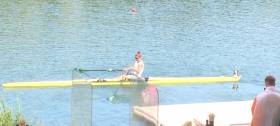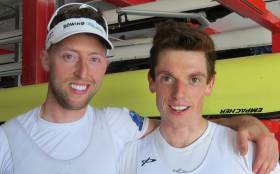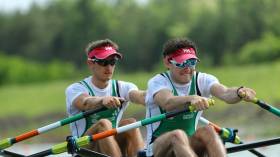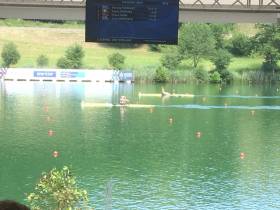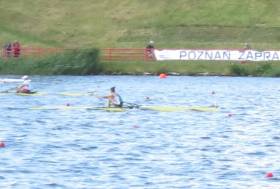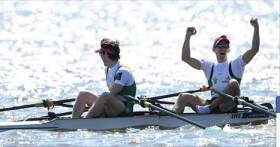Displaying items by tag: Lucerne
Puspure So Close to A Final Place in Lucerne World Cup
#Rowing: Ireland’s Sanita Puspure and Monika Dukarska finished fourth and sixth in their semi-final today and will take part in the B Final at the World Cup Regatta in Lucerne. Magdalena Lobnig of Austria, Annekatrin Thiele of Germany and Vicky Thornley of Britain took the qualifying places, in that order, but Puspure was finishing fast and came within a second of overtaking Thornley, who just held on to that vital third place.
World Cup Regatta, Lucerne – Day Two (Irish interest)
Women
Single Sculls Semi-Finals (First Three to A Final; rest to B Final) – Semi Final One: 1 Austria (M Lobnig) 7:35.06, 2 Germany (A Thiele) 7:35.96, 3 Britain (V Thornley) 7:36.09; 4
Ireland One (S Puspure) 7:36.90; 6 Ireland Two (M Dukarska) 7:55.0.
#Rowing: Paul O’Donovan and Gary O’Donovan won their repechage to qualify for the semi-finals of the lightweight double sculls at the World Cup Regatta in Lucerne today. The Skibbereen men had not intended to be in the race – run in very hot conditions – but they judged it well, taking out both Russia and Denmark in the final 200 metres.
World Cup Regatta, Lucerne, Day One (Irish interest)
Men
Lightweight Pair – Exhibition Race: 1 Britain (J Cassells, S Scrimgeour) 6:57.32, 2 Ireland (M O’Donovan, S O’Driscoll) 6:59.26, 3 Brazil 6:59.29.
Lightweight Double Sculls (First Two to A/B Semi-Finals; rest to Repechage) – Heat One: 1 France 6:27.36, 2 Britain One 6:30.70. Heat Two: 1 Greece 6:25.88, 2 Czech Republic 6:26.39; 3 Ireland (G O’Donovan, P O’Donovan) 6:28.63. Heat Three: 1 Italy 6:29.15, 2 Belgium 6:32.44.
Repechage One (First Three to A/B Semi-Final; rest to C Final): 1 Ireland 6:44.33, 2 Denmark 6:45.71, 3 Russia 6:45.91.
Women
Single Sculls (Three to Quarter-Finals; rest to quarters or E Final) – Heat Three: 1 Austria (M Lobnig) 7:46.97, 2 Ireland Two (M Dukarska) 7:51.44, 3 Latvia (E Gulbe) 8:02.20.
Heat Five: 1 Britain (V Thornley) 7:45.65, 2 Ireland One (S Puspure) 7:47.84, 3 Finland (E Karppinen) 7:58.04.
Quarter-Finals (First Three to A/B Semi-Finals): QF One: 1 Ireland (Puspure) 7:52.50, 2 United States (F Mueller) 7:53.39,
3 Belarus (E Karsten) 7:59.13.
QF Three: 1 Canada (C Zeeman) 7:57.04, 2 Germany (A Thiele) 8:01.51, 3 Ireland (Dukarska) 8:03.64.
#Rowing: Both of Ireland’s competitors made the semi-finals of the women’s single sculls at the World Cup in Lucerne. Sanita Puspure won her quarter-final, while Monika Dukarska took a comfortable third in hers.
Puspure had tough opponents. She battled it out with Felice Mueller of the United States and Ekaterina Karsten of Belarus throughout. They moved away from the rest of the field and though all three were all but guaranteed to take the qualification places, Puspure finished impressively to win.
Dukarska’s third was a clear one. Again, three women broke free. Carling Zeeman took over to win, with Annekatrin Thiele of Germany second and Dukarska not far behind – over 11 seconds clear of Eeva Karppinen of Finland in fourth.
World Cup Regatta, Lucerne, Day One (Irish interest)
Men
Lightweight Pair – Exhibition Race: 1 Britain (J Cassells, S Scrimgeour) 6:57.32, 2 Ireland (M O’Donovan, S O’Driscoll) 6:59.26, 3 Brazil 6:59.29.
Lightweight Double Sculls (First Two to A/B Semi-Finals; rest to Repechage) – Heat One: 1 France 6:27.36, 2 Britain One 6:30.70. Heat Two: 1 Greece 6:25.88, 2 Czech Republic 6:26.39; 3 Ireland (G O’Donovan, P O’Donovan) 6:28.63. Heat Three: 1 Italy 6:29.15, 2 Belgium 6:32.44.
Women
Single Sculls (Three to Quarter-Finals; rest to quarters or E Final) – Heat Three: 1 Austria (M Lobnig) 7:46.97, 2 Ireland Two (M Dukarska) 7:51.44, 3 Latvia (E Gulbe) 8:02.20.
Heat Five: 1 Britain (V Thornley) 7:45.65, 2 Ireland One (S Puspure) 7:47.84, 3 Finland (E Karppinen) 7:58.04.
Quarter-Finals (First Three to A/B Semi-Finals): QF One: 1 Ireland (Puspure) 7:52.50, 2 United States (F Mueller) 7:53.39,
3 Belarus (E Karsten) 7:59.13.
QF Three: 1 Canada (C Zeeman) 7:57.04, 2 Germany (A Thiele) 8:01.51, 3 Ireland (Dukarska) 8:03.64.
#Rowing: Shane O’Driscoll and Mark O’Donovan finished well to take second in their lightweight pair exhibition race at the World Cup regatta in Lucerne today. Britain’s Joel Cassells and Sam Scrimgeour took over at the head of the field Ireland crew early on and stayed there despite pushes by Brazil and Ireland. The South American crew looked to have taken second coming up to the line, but O’Driscoll and O’Donovan snatched it from them by three hundredths of a second.
The Final is on tomorrow, Saturday.
World Cup Regatta, Lucerne, Day One (Irish interest)
Men
Lightweight Pair – Exhibition Race: 1 Britain (J Cassells, S Scrimgeour) 6:57.32, 2 Ireland (M O’Donovan, S O’Driscoll) 6:59.26, 3 Brazil 6:59.29.
Lightweight Double Sculls (First Two to A/B Semi-Finals; rest to Repechage) – Heat One: 1 France 6:27.36, 2 Britain One 6:30.70. Heat Two: 1 Greece 6:25.88, 2 Czech Republic 6:26.39; 3 Ireland (G O’Donovan, P O’Donovan) 6:28.63. Heat Three: 1 Italy 6:29.15, 2 Belgium 6:32.44.
Women
Single Sculls (Three to Quarter-Finals; rest to quarters or E Final) – Heat Three: 1 Austria (M Lobnig) 7:46.97, 2 Ireland Two (M Dukarska) 7:51.44, 3 Latvia (E Gulbe) 8:02.20.
Heat Five: 1 Britain (V Thornley) 7:45.65, 2 Ireland One (S Puspure) 7:47.84, 3 Finland (E Karppinen) 7:58.04.
#Rowing: Ireland’s Paul O’Donovan and Gary O’Donovan finished third in their heat and must come through a repechage if they are to qualify for the semi-finals of the lightweight double sculls at the World Cup Regatta in Lucerne.
Just two crews qualified directly and the Ireland crew trailed Greece and the Czech Republic through the four quarters of the race. With 250 metres to go the men in green looked set to take out at least one of the two, but both powered on and Ireland, stuck in third, faded back coming up to the line.
World Cup Regatta, Lucerne, Day One (Irish interest)
Men
Lightweight Double Sculls (First Two to A/B Semi-Finals; rest to Repechage) – Heat One: 1 France 6:27.36, 2 Britain One 6:30.70.
Heat Two: 1 Greece 6:25.88, 2 Czech Republic 6:26.39; 3 Ireland (G O’Donovan, P O’Donovan) 6:28.63.
Heat Three: 1 Italy 6:29.15, 2 Belgium 6:32.44.
Women
Single Sculls (Three to Quarter-Finals; rest to quarters or E Final) – Heat Three: 1 Austria (M Lobnig) 7:46.97, 2 Ireland Two (M Dukarska) 7:51.44, 3 Latvia (E Gulbe) 8:02.20.
Heat Five: 1 Britain (V Thornley) 7:45.65, 2 Ireland One (S Puspure) 7:47.84, 3 Finland (E Karppinen) 7:58.04.
Puspure and Dukarska Race into Lucerne Quarter-Finals
#Rowing: Monika Dukarska and Sanita Puspure both qualified for the quarter-finals of the women’s single sculls at the World Cup regatta in Lucerne today.
Dukarska drew Magdalena Lobnig, the holder of the world’s best time in the event, in her heat. The Killorglin woman stuck with the Austrian as others let her go and finished second.
Puspure also took second in her heat, refusing to let Britain’s Victoria Thornley dominate the race. The two matched each other over the final stages, though both eased up coming to the line, with Thornley taking the victory by two seconds.
World Cup Regatta, Lucerne, Day One (Irish interest)
Women
Single Sculls (Three to Quarter-Finals; rest to quarters or E Final)
Heat Three: 1 Austria (M Lobnig) 7:46.97, 2 Ireland Two (M Dukarska) 7:51.44, 3 Latvia (E Gulbe) 8:02.20.
Heat Five: 1 Britain (V Thornley) 7:45.65, 2 Ireland One (S Puspure) 7:47.84, 3 Finland (E Karppinen) 7:58.04.
Ireland Go For Gold at World Rowing Cup in Lucerne
#Rowing: The third and final World Rowing Cup regatta of the 2017 season will take place in Lucerne, Switzerland on the famous Rotsee course, beginning this Friday, July 7th.
The regatta is the last chance for athletes to test themselves before the main event of the year, the 2017 World Rowing Championships, which will be held in Florida in September and October.
The World Cup regatta has an entry of almost 700 competitors from 54 counties. The waters of the Rotsee are ideal for competitive rowing as the lake’s size and shape enable Olympic-style six-lane racing over 2,000 metres. It is arguably the fairest course in the world.
The World Cup series consists of a series of three events, with the overall World Rowing Cup winners being determined after the third event. The events in which competitors can be World Cup champions mirror those at the Olympic Games.
Gary and Paul O’Donovan took silver at the second World Cup in Poznan. They had finished fourth in the first World Cup in Belgrade and are in contention to become overall winners of this World Cup event. Shane O’Driscoll and Mark O’Donovan won gold in the lightweight pair, an international event, at the first World Cup in Belgrade and the second in Poznan. Lightweight single sculler Denise Walsh, who is not travelling to Lucerne, took silver in Belgrade.
The Ireland team is:
Lightweight Men’s Double Sculls: Gary O’Donovan (Skibbereen RC), Paul O’Donovan (Skibbereen RC)
Lightweight Men’s Pair: Mark O’Donovan (Skibbereen RC), Shane O’ Driscoll (Skibbereen RC)
Women’s Single Sculls: Sanita Puspure (Old Collegians BC); Monika Dukarska (Killorglin RC)
Dukarska Chosen in Ireland Team for Final World Cup
#Rowing: Monika Dukarska has been chosen to represent Ireland at the third World Cup Regatta in Lucerne early next month. The Killorglin woman finished ninth (third in the B Final) on her first foray as a single sculler at a World Cup event, in Poznan in Poland last weekend. She joins Sanita Puspure, who won the B Final in Poland. The Ireland lightweight pair of Shane O’Driscoll and Mark O’Donovan, who have taken gold in the previous two World Cups and in the European Championships will hope to continue their run. The lightweight double of Paul and Gary O’Donovan were silver medallists at the Europeans and in the World Cup in Poznan.
Irish Denied Bronze at Finish in World Cup Final
#Rowing: Ireland’s Paul and Gary O’Donovan finished fourth in the A Final of the lightweight double sculls at the World Cup in Lucerne this morning. France's new crew of Pierre Houin and Jeremie Azou were impressive winners, with Norway holding off charges by South Africa and Ireland in the final 250 metres to take silver. The young Ireland crew pushed hard but South Africa took the bronze by just over a second. Britain’s Will Fletcher and Richard Chambers were a length behind Ireland in fifth.
World Cup Regatta, Lucerne, Switzerland (Irish interest; selected results)
Men
Lightweight Pair – A Final: 1 Britain (J Cassells, S Scrimgeour) 6:31.03.
Lightweight Double Sculls – A Final: 1 France (P Houin, J Azou) 6:19.26, 2 Norway 6:21.81, 3 South Africa 6:22.42; 4 Ireland (G O’Donovan, P O’Donovan) 6:23.46, 5 Britain (W Fletcher, R Chambers) 6:25.72, 6 United States 6:28.08.
Women
Lightweight Double Sculls – B Final (Places 7 to 12): 1 Ireland (C Lambe, S Lynch) 7:01.36, 2 Poland 7:03.01, 3 Britain 7:04.88.
Driven Irish Win B Final in Lucerne
#Rowing: Ireland’s lightweight women’s double won the B Final emphatically at the World Cup Regatta in Lucerne this morning, placing seventh at this prestigious regatta. The crew of Sinéad Lynch (née Jennings) and Claire Lambe had come very close to taking an A Final place. They dominated this B Final. The race was quite close early on, but Ireland took control before half way and carved out a clear water lead. Poland were second and Britain third.
World Cup Regatta, Lucerne, Switzerland (Irish interest; selected results)
Men
Lightweight Pair – A Final: 1 Britain (J Cassells, S Scrimgeour) 6:31.03.
Women
Lightweight Double Sculls – B Final (Places 7 to 12): 1 Ireland (C Lambe, S Lynch) 7:01.36, 2 Poland 7:03.01, 3 Britain 7:04.88.


























